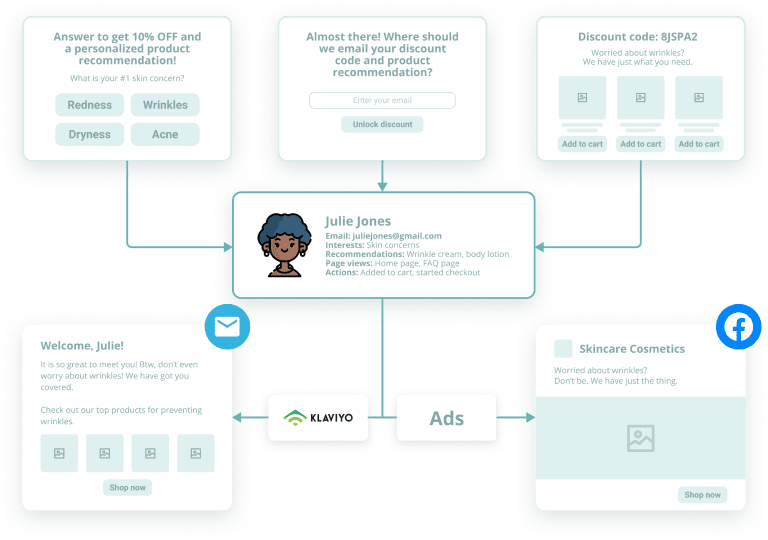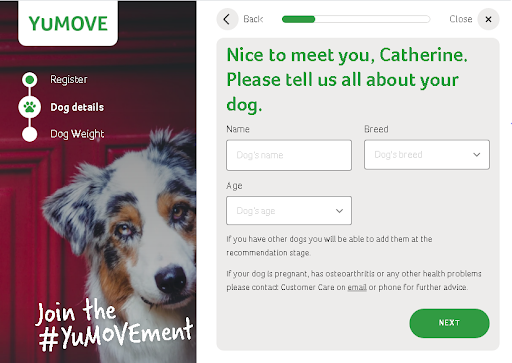How to Kickstart Your Zero-Party Data Marketing Strategy This Black Friday
What better time to double down on your zero-party data collection than the BFCM weekend when store traffic skyrockets! Find out why this type of data is so important for your ecommerce brand, best practices for collecting it, and how you can leverage it in the long-term.
Written By
Hannah Smiddy

It’s that time of the year when our inboxes get flooded with newsletters shouting about sensational sales and dazzling discounts, pepping us up for a weekend of frantic buying. You guessed it, Black Friday is coming.
However, not every brand will be slashing their prices for the BFCM period. Whether they’re actively taking a stand against hyper-consumption, or don’t see the need for temporary discounting because their prices are low and competitive all year round, some retailers have simply decided that Black Friday isn’t right for them.
Even if you’re not dishing out discount codes this year, Black Friday still represents a valuable opportunity for retailers. You can harness the natural increase in online traffic and use it as a chance to collect lots of high-quality zero-party data – data that you can then leverage to develop meaningful, long-lasting relationships with your customers and ultimately drive revenue.
“The BFCM weekend represents a valuable chance to get to know your audience a little better and kickstart your zero-party data marketing strategy.
Whilst many retailers will be pouring all their efforts into aggressive promotions and churning out cheap stock in an attempt to grab as much revenue as possible over the BFCM weekend, this is a great time to double down on your data collection.
The more information you can gather directly from consumers, and the richer this information is, the more tailored the experiences you can create and the stronger the relationships you can build. Looking beyond the four days of the BFCM weekend, having a solid base of zero-party data opens up an excellent opportunity to build revenue in the long-term.”
– Jake Martin, Growth Accelerator Service Team Lead at Swanky
In this article, we’ll be exploring exactly how you can collect zero-party data on your ecommerce store this Black Friday, plus how it can be utilised in your marketing strategy once the retail bonanza is over. But first, some definitions, as well as a bit of context around why zero-party data is a hot ecommerce topic right now.
What is zero-party data?
Let’s rewind a second. What exactly is zero-party data and how can you use it to transform your marketing strategy?
Zero-party data is a term given to describe information that you collect directly from consumers. It’s different from third-party data, which, as the name suggests, is collected and owned by third parties like Facebook and other ad platforms. Zero-party data is explicitly and freely given by shoppers, usually with the expectation that giving their data will lead to a better, more tailored shopping experience – it’s information that a customer wants a brand to know about them.
There are multiple benefits of zero-party data. For instance, as it has come intentionally and proactively from your customers, you can be confident in its quality and relevancy. And when it comes to compliance, you know the source of the data, as well as how it was collected – minimising risk for you as a retailer. What’s more, implementing this type of marketing strategy gives you full control over your customer data and resulting relationships.
Zero-party data can be leveraged to provide personalised experiences on your ecommerce site and across your owned marketing channels (like email and SMS). By getting to know your customers and tailoring their experiences of your brand, you’re well placed to maximise all those metrics that matter most: conversion rate, average order value, email engagement, revenue and retention. In fact, according to Octane AI, brands who implement zero-party data marketing connect with 16x more customers on email and SMS, enjoy 6x sales conversions, and have increased revenue by over 50%1! Plus, with reduced acquisition costs, higher conversion rates and higher customer lifetime value, personalisation provides an excellent return on investment.
Why does my brand need zero-party data marketing?
Why is everyone talking about zero-party data? Why the urgency to stop relying on third-party data?
The way brands collect customer data and track advertising performance has fundamentally changed. Apple has stopped supporting pixels and third-party data tracking, meaning that individuals now have to give explicit permission for advertisers to track their activity across websites. And it’s not just Apple – Google is following suit too and scrapping the use of third-party cookies2.
So, if someone doesn’t give permission for tracking, and they visit your site without leaving an email address or other contact details, you’re stuck when it comes to getting in touch with them.
This means that it’s time to adapt. It’s more important than ever for retailers to start collecting data directly from customers and move away from so-called “rented relationships”.
You might be wondering why Black Friday is a good time to kickstart your zero-party data collection. Well, with the natural uplift in online traffic around BFCM, it makes sense to capitalise on this and gather as much data as you can!
How to collect zero-party data this Black Friday
There are a host of ways you can capture zero-party data on your ecommerce store and across your marketing channels, a couple of which we’ll explore below.
Of course, how you collect zero-party data depends on what sort of data you want to capture, so bear this in mind when planning your collection strategy.
Also, try to avoid asking customers for too much information at once. You don’t want to bombard them with questions and leave them feeling bewildered, especially around Black Friday when they’re already likely to be overwhelmed with brands competing for their attention.
Conversational pop-ups
First up, conversational pop-ups. You can set these up to appear at various points in a customer’s on-site journey.
How about greeting new site visitors with a friendly question (or questions) to start getting to know them a little better? You could ask them what type of product they’re after, what they’re looking for help with, or who they’re shopping for (is it for a baby, or a pet, for example?). Be strategic with your questions! Many shoppers will be on the lookout for Christmas gifts during the BFCM period, so consider asking whether this is the case.
Follow this up by asking for their email address or contact number, before displaying your tailored product or content recommendations (complete with “Buy now” button) right there in the pop-up.
The data you’ve collected directly from your customers can then be stored and used to personalise the content you show them, products you promote, and emails or SMS messages you send.

Source: “What is a Conversational Pop-Up?”, Octane AI
Make sure your pop-ups tie in with the look and feel of your brand, sticking to the same fonts, colours and imagery that you use across your website. Communicating in a friendly, positive tone is important, too. You want to avoid sounding “salesly” and instead focus on building trust with a welcoming, conversational approach. This is especially important around Black Friday, when consumers will be bombarded with pushy pop-ups.
Quizzes and surveys
For a great way to engage your audience whilst getting to know them on a deeper level, look no further than a product quiz this Black Friday. Customers will be willing to share answers with you because they know they’ll benefit from a tailored experience in return.
By asking customers a series of targeted questions, you can build a detailed identity profile and determine what sort of products are right for them. You can also use the information they provide to connect them with relevant advice and guidance from across your blog and FAQ pages.
If you’re a skincare retailer for instance, you could frame your quiz as a “routine-builder” and ask shoppers things like what sort of skin they have, what their age is, and if they’re allergic to any ingredients – information you need to be able to put together the perfect skincare routine.
Or if you sell coffee, you might want to find out about people’s flavour preferences, consumption habits and budget, in order to recommend a specific product or subscription.
Finish off by asking customers to submit their contact information in order to receive their quiz results. This is essential for ongoing contact!
Now, with some valuable zero-party data under your belt, you’re in a position to provide a custom experience that promotes content and products that are applicable to each individual customer, which is super important for building profitable, long-term relationships beyond the holiday season.
Leading pet supplement brand YuMove have done exactly this on their Shopify Plus store. By asking first-time customers questions about their pets and their individual needs in an interactive quiz, they’re able to suggest the most suitable products, as well as promote relevant content that provides value to the customer.

Source: YuMove
How to leverage zero-party data in your marketing strategy beyond Black Friday
Once the BFCM weekend has been and gone, you’ll have a valuable base of zero-party data at your disposal. Make sure you sync this with your marketing platforms in order to leverage the data in your flows and campaigns.
There are lots of ways you can use this information about your customers to provide a personalised shopping experience – here are just a few:
Personalised product recommendations
Instead of recommending the same products to all your shoppers, you can display personalised recommendations based on what you know a customer would like.
Not only can you instantly display these recommendations on your site according to the information you receive, you can incorporate these suggestions into your automated email flows to create messages that really resonate with your customers.
Tailored email flows
Talking of email flows, your welcome series can certainly benefit from zero-party data. With your insights into your customers and their preferences, you can build a welcome flow that treats everybody as an individual – no more one-size-fits-all emails. You want to spark a conversation with each customer, as if you’re speaking to them personally. This is a surefire way to impress your customers and start establishing trust – key for building the foundations of prosperous relationships.
Look to use zero-party data to add a personal touch to your post-purchase emails too. By tailoring the content based on the answers they provided during your quiz or on a pop-up, you’re showing your customer that you understand their unique needs and are here to provide the perfect solution.
You can also use the information you learn to personalise your email subject lines according to your customers’ needs and preferences. By crafting a unique subject line just for them, you can cut through the noise in their inbox and increase the chance of them opening your email.
Overall, implementing a zero-party data email marketing strategy can do wonders for your open rates, click-through rates and conversions.
Custom content
Leverage what you learn about your customers to display copy and images that match their intent. For instance, a pet food brand might choose to show photos of dogs rather than cats on their homepage if a customer has specifically indicated in a quiz that they have a pet dog.
Small tweaks like this can go a long way in making a customer feel like they’ve been seen and heard by a brand, thus inspiring loyalty.
In summary
Black Friday is the perfect time to capitalise on an influx of online traffic and focus on capturing high-quality zero-party data. By gathering information directly from your customers, you can serve up unique 1:1 experiences across multiple channels and cultivate rich relationships with your shoppers that last long after the BFCM weekend is over.
Your ecommerce marketing experts
There’s plenty more where this came from! Our team of in-house specialists know exactly what it takes to unlock your brand’s ecommerce potential with commercially-guided, experience-led growth strategies. Contact us today to find out more!
For reference:
[1] https://www.octaneai.com/blog/the-complete-guide-to-zero-party-data-marketing-for-ecommerce-merchants
[2] https://www.bloomberg.com/news/articles/2021-04-26/how-apple-google-are-killing-the-advertising-cookie-quicktake

